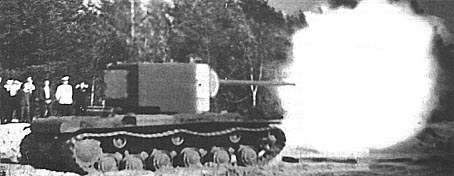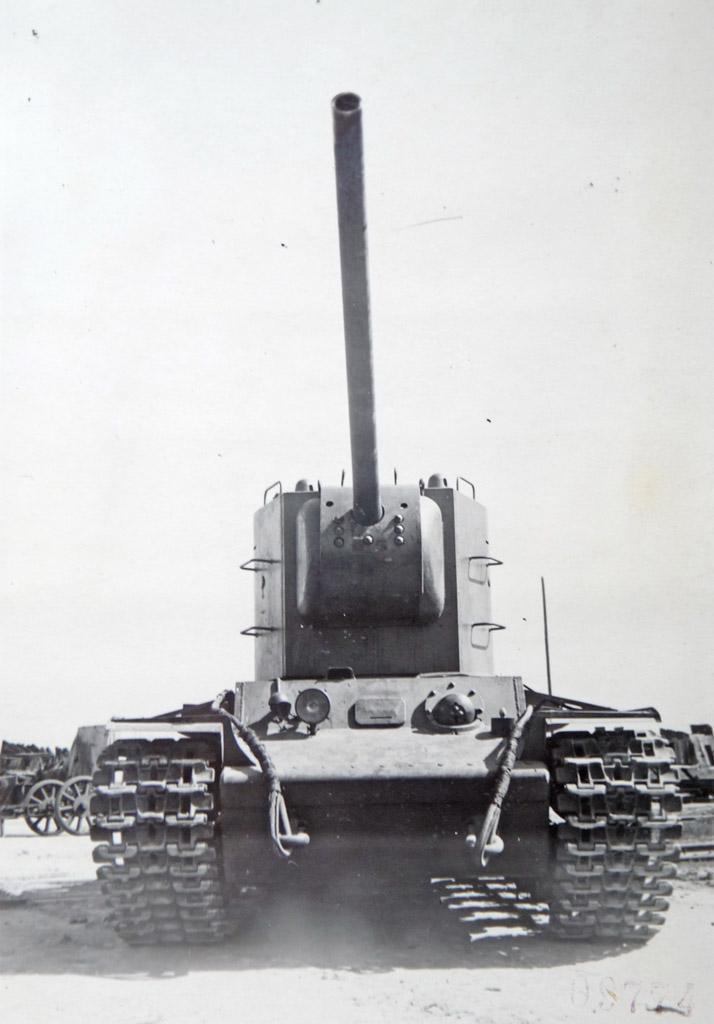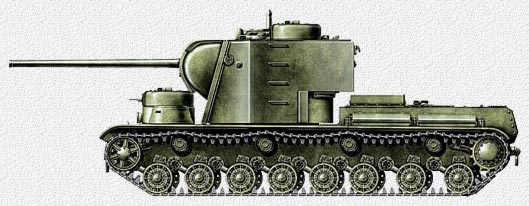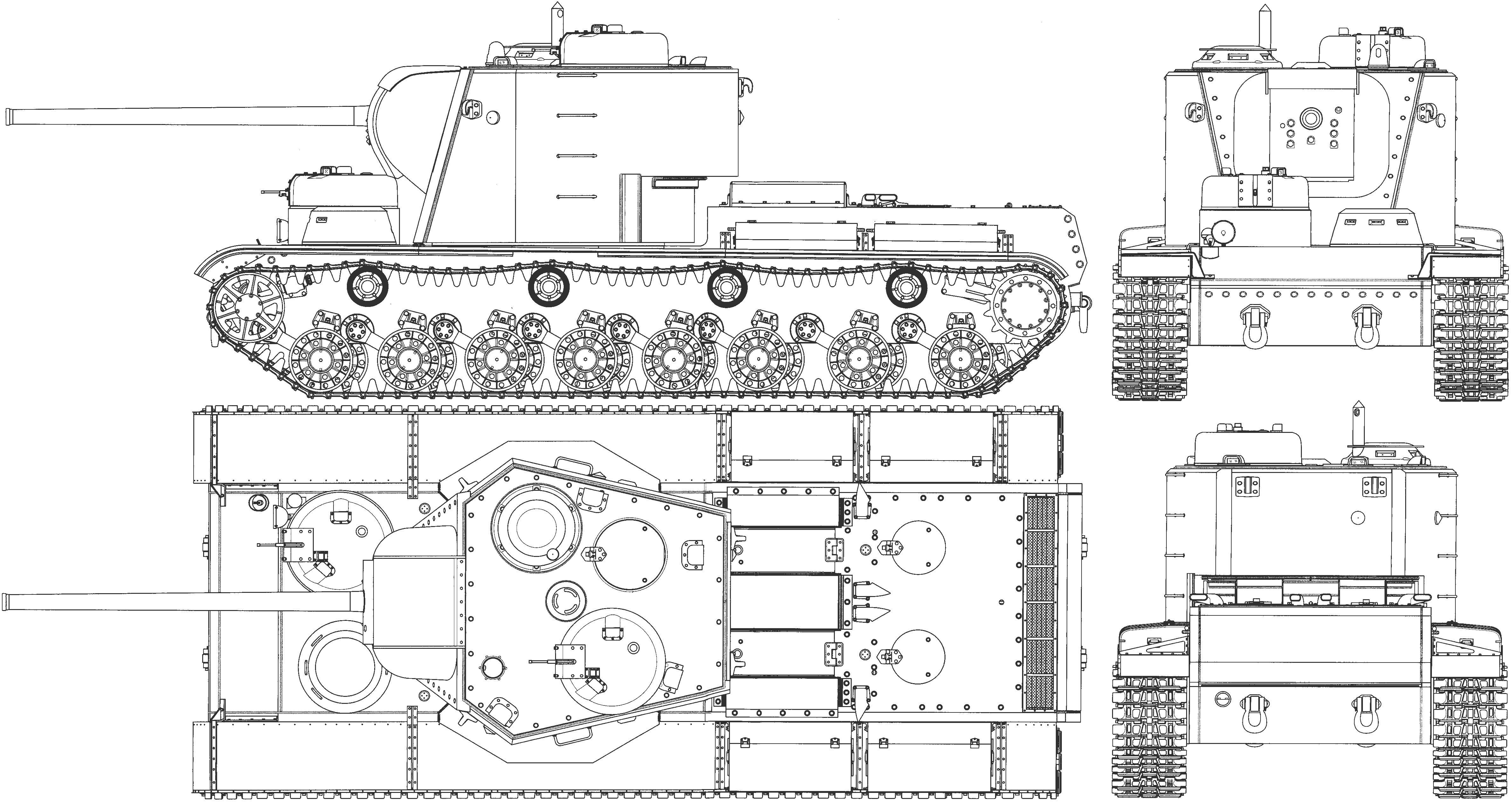| Golden Journal No. 54
Stalin’s Tanks
The KV5 Tiger Killer
by Mike Bennighof, Ph.D.
September 2024
 On 11 March 1941, Soviet military intelligence delivered a report to the Central Committee of the Communist Party of the Soviet Union, titled “The direction of development of German armed forces and changes in their state.” Its arrival shocked the members into immediate action, not least the claim that the Germans had a 90-ton heavy tank in development, with thick armor and a 105mm main gun. Chairman Josef Stalin himself took the lead in making sure that the Red Army had a counter to this Nazi behemoth. On 11 March 1941, Soviet military intelligence delivered a report to the Central Committee of the Communist Party of the Soviet Union, titled “The direction of development of German armed forces and changes in their state.” Its arrival shocked the members into immediate action, not least the claim that the Germans had a 90-ton heavy tank in development, with thick armor and a 105mm main gun. Chairman Josef Stalin himself took the lead in making sure that the Red Army had a counter to this Nazi behemoth.
Marshal of the Soviet Union, Grigory Kulik, head of the Artillery Directorate, had already begun agitating for a new heavy tank with a gigantic 107mm high-velocity cannon. Stalin personally called the Red Army’s top designer of artillery V.G. Grabin of Plant No. 92 in Gorkiy, to seek his opinion. Perhaps fittingly, Grabin at the moment had traveled to Leningrad to lecture engineering students on “high-speed design methods.” Grabin agreed with the Comrade General Secretary that the current 76.2mm gun of Soviet heavy tanks was inadequate, though he had designed it himself. A heavy tank should have a gun capable of defeating its own armor. Stalin told him to get to work on such a gun.
Stalin demanded a prototype ready for testing in 45 days; Grabin delivered one in 38 days, invoking the Vozhd’s order to mobilize all of the personnel, equipment and facilities required. He pulled many elements of his 107mm F42 tank gun which had been tested in March 1941 but had proven too heavy to be easily mounted in a tank; this weapon was in turn a development of his 95mm F39 tank cannon that he had suggested for a T34/95 close-support tank. Testing of the new gun began in late April, and within days the new ZiS-6 107mm high-velocity cannon had been instated in the turret of a KV-2 heavy tank, with firing trials beginning on 14 May 1941.

Test-firing the ZiS-6. V.G. Grabin is second from the right, in the white jacket.
The gun proved capable of penetrating up to 230mm of armor at 1,000 meters’ range: not far short of a battleship’s belt armor. It could still punch through 120mm of 30-degree sloped armor at 1,600 meters. For comparison’s sake, a German Royal Tiger heavy tank had a maximum armor thickness of 185mm, while the mythical Panzer Maus went to 220mm. The Panther tank sported 100mm of sloped armor. The high-explosive round of the ZiS-6, the same as that of the 107mm M60 divisional cannon, delivered a charge of over 2 kilograms. The cannon could fire every round in the field gun’s inventory, but the tank was only expected to carry armor-piercing and high-explosive, and perhaps smoke.
Grabin had delivered an outstanding weapon, but now it needed a tank in which to mount it. The expedient of replacing the 152mm howitzer of the KV2 with the new 107mm ZiS-6 was quickly discarded; the new German heavy tanks were expected to carry a version of their 105mm Flak 38. The Soviets had purchased examples of this gun and knew that it would shred the KV2’s protection, even with the suggested added armor. The new gun would need a survivable tank.

The KV2 testbed, with 107mm ZiS-6. |
Design work began on the KV3 in March 1940, a month after the KV1 and KV2 entered mass production. It used the hull of the KV220 heavy tank project, with a new and enlarged turret to mount the 107mm F42 in place of the 85mm gun carried by the KV220. The main gun was upgraded to the new ZiS-6, but the Izhora tank plant just outside Leningrad, charged with the project’s development, proved unable to produce a prototype before September 1941, when its staff and machine tools were hurriedly relocated to Chelyabinsk in the Ural Mountains. Though the engineers and their materials made the journey, the work of re-starting KV production at the huge “Tankograd” Works made it impossible to craft a prototype.
A number of KV4 projects, a series of paper design studies, featured the ZiS-6, but Grabin pinned his hopes on the KV5. The Izhora plant had responsibility for this project as well, with a target date of September 1941 to deliver a working prototype.
The KV5 featured a tall, six-sided turret with a slight inward slope (15 degrees) to improve protection, allowing the main gun to be loaded at any angle. To reduce the tank’s target profile, the hull would be reduced in height and special “caps” (raised, armored stations) provided so the radio operator and driver could fit within the hull. This gave the driver better visibility than in the KV1 or KV2, and allowed the radio operator to have a turret for his machine gun; the driver’s station could be lowered closer to the hull when the tank entered battle. The tank commander, turret machine-gunner, gunner, and loader all fit easily into the turret, which sported an armored machine-gun turret atop the roof. The big main gun had exceptionally long, two-part ammunition, necessitating a large working area to keep it fed with fresh shells.

Artist’s conception of the KV5.
That huge turret, even with the reduced hull, would have made for a prime target, and so the tank had plenty of armor, 150mm to 180mm on both hull and turret. It would also make for a very heavy vehicle, coming in at an even 100 tons. That was the target weight, anyway; like any other project, the KV5 probably would have exceeded that figure. The tank would be 11 meters long (even longer than the 188-ton Panzer Maus) and four meters tall (slightly taller than Panzer Maus).
Even at 100 tons, it could not be transported by existing railroad flatcars. The Armored Forces Directorate asked the Commissariat of Railways to prepare a new heavy-duty flatcar capable of transporting a 100-ton tank. The special flatcar would have an extra set of wheels fitted under the middle of the car (12 instead of the usual eight), and use the heavier wheels made for the Soviet standard FD steam locomotive. The Red Army desired production of 200 of these cars in 1941 and another 1,500 in 1942. That would obviously be in excess of the number of KV-5 tanks produced (since the railcars would not always be available in the desired location), but does indicate that the Armored Forces Directorate intended to field a great many heavy tanks.
Mobility would be a key issue, and after the poor performance of the T35 heavy tank in the 1930’s the KV-5 would have a brand-new, 1,200-horsepower diesel engine designed at Leningrad’s Kirov Engine Plant. When the Kirov plant failed to deliver, the design switched to two conventional V-12, 600-horsepower diesels mounted side-by-side (one of these engines powered the 52-ton KV-2).

Schematic of the KV5.
The KV5 would have been much more sophisticated, and therefore more difficult to build, than other Soviet tanks, requiring more skilled labor. The rolled armor plates of the turret, like those of a battleship, would have been connected by dovetail joints, just like a battleship’s armor. The hull’s plates would be electrically welded.
The evacuation of the Izhora plant to Chelyabinsk ended work on the project, and its 67-year-old lead designer Nikolai V. Tseits was arrested and briefly sent to labor in a Siberian gold mine; he was soon released thanks to the Armored Forces Directorate’s intervention and returned to work. The design had been completed by the time of his arrest, and production had begun on a few components including the massive main gun. Five of these rolled off the line at Plant No. 92 in Gorkiy before production shut down.
For all of its prowess against German armor, the KV-5 would have entered the battlefield with some significant liabilities. Very few bridges in the Soviet Union could bear its weight, and it would instantly sink into wet or swampy ground, kind of a constant presence in the Soviet Union. The design team claimed the tank would make 40 kilometers per hour cross-country, but it seems likely that the tank would have moved at something closer to the KV-2’s 16 kilometers per hour. While the armor appears impressive on paper, the tank was much larger than the broad side of a barn and would have been nearly impossible for enemy gunners to miss.
 Golden Journal No. 54: Stalin’s Tanks includes the KV5, so you can slay Tigers and Panthers on the battlefields of Kursk. Golden Journal No. 54: Stalin’s Tanks includes the KV5, so you can slay Tigers and Panthers on the battlefields of Kursk.
The Golden Journal is only available to the Gold Club (that’s why we call it the Golden Journal).
Click here to join the Gold Club.
See your Gold Club Insider newsletter for ordering information.
Sign up for our newsletter right here. Your info will never be sold or transferred; we'll just use it to update you on new games and new offers.
Mike Bennighof is president of Avalanche Press and holds a doctorate in history from Emory University. A Fulbright Scholar and NASA Journalist in Space finalist, he has published a great many books, games and articles on historical subjects; people are saying that some of them are actually good.
He lives in Birmingham, Alabama with his wife, three children, and new puppy. He misses his lizard-hunting Iron Dog, Leopold.
Daily Content includes no AI-generated content or third-party ads. We work hard to keep it that way, and that’s a lot of work. You can help us keep things that way with your gift through this link right here.
|
